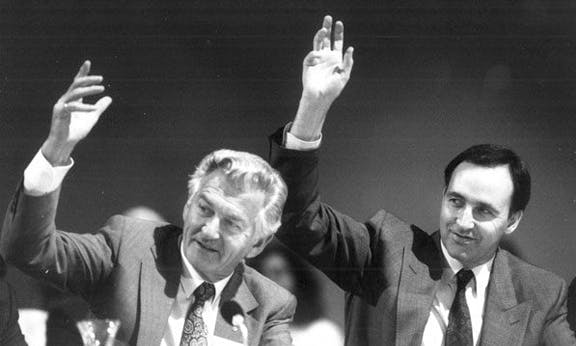The ALP, pioneer of neoliberalism

Former treasurer Wayne Swan denies that the Hawke and Keating governments of 1983-96 and the Rudd and Gillard governments of 2007-13 were responsible for the introduction and maintenance of neoliberal policies in Australia.
While accepting, indeed boasting of, Hawke and Keating’s “economic reform” program, their dismantling of tariff barriers and their “unleashing of market forces”, Swan, in a Guardian column on 14 May, argues that these governments also ensured that the working class was not left behind.
How could the Labor governments of the 1980s and 1990s be champions of neoliberalism, Swan asks, if they introduced Medicare and a capital gains tax and expanded spending on health, education and social security? How could the Rudd and Gillard governments be neoliberal if they proposed an emissions trading scheme, the National Broadband Network and a disability insurance scheme? How could Labor’s critics overlook the party’s record of lifting living standards while maintaining social equity?
The facts don’t support Swan. Even the best aspects of Labor’s program, such as Medicare, were limited. (Australia’s system of socialised health insurance, for example, falls well short of the British National Health Service, and its introduction was used by the government as an excuse to cut wages.) And the few reforms introduced were massively outweighed by the overall program of the Labor governments of 1983-96 and 2007-13.
Far from protecting the working class and maintaining social equity, the Hawke government did the opposite. As author and ALP member Graham Maddox wrote in 1989 in his The Hawke government and Labor tradition:
“[The Hawke government] presided over an economy in which, as the fortunes of our richest people rose and fell by hundreds of millions of dollars and entrepreneurs made millions in overnight deals, real wages continued to decline, poverty traps closed sharply over the unemployed and the employed poor and propertyless pensioners despaired over an inadequate subsidy.”
Overall spending on health, education and social security increased, but the system became more and more draconian. By 1996, Australia had the most severely means-tested system of social security in the OECD, and recipients were subjected to increasingly intrusive questioning and inspections.
Free tertiary education, one of the genuine reforms of the Whitlam government, was eliminated, and student fees began their inexorable rise.
Over the course of the Hawke and Keating governments, corporate tax rates were cut from 48 percent to 36 percent, marginal tax rates on the rich were also brought down dramatically, and the government was held back from introducing a GST in 1983 only by a union revolt. Privatisation was introduced, and Telecom and then the Commonwealth Bank went on the chopping block, along with the national shipping line.
The system of industrial awards setting employment standards for workers across industries and occupations was gradually whittled away during the 1980s. And in 1991, the Keating government introduced enterprise bargaining, which has been responsible for increasing wage inequalities and undermining union solidarity.
Through it all, the richest of the rich – the Kerry Packers, the Alan Bonds, the Holmes-a-Courts, not to mention Rupert Murdoch – loved yukking it up with Bob Hawke. And Paul Keating was named “finance minister of the year” by an international business magazine for his work in deregulating the banking system and floating the dollar.
Given their record, it is little wonder that the Hawke and Keating governments are to this day held up as the gold standard of economic “reform” by Financial Review editorialists and Treasury economists.
All this came at the expense of the working class, which savagely turned on the ALP. The party’s primary vote shrank in virtually every election until it was ignominiously booted out of power in 1996 with its lowest vote since the Great Depression. Few workers shed any tears at its passing. In spite of all this, Swan, like John Howard before him, basically just says that workers never had it so good.
What of the Rudd and Gillard governments?
Treasurer Wayne Swan’s first budget in 2008 was pure neoliberal economics, implementing Howard government income tax cuts that disproportionately favoured the well paid. Swan’s budget also promised to cut public spending by $33 billion over the following four years. According to Melbourne’s Herald Sun newspaper, “Swan’s first budget looks like being the one [Howard government treasurer] Peter Costello always wanted to deliver”.
The global financial crisis of 2008-09 turned everything upside down. Faced with economic collapse, the government introduced two stimulus packages worth $52 billion. But other than some cash handouts to the population in the first package and a boost to the age pension, the bulk of the stimulus consisted of handouts to the private sector. The government also announced that it would give the big four banks assistance worth billions of dollars.
What of the emissions trading scheme, the National Broadband Network and the disability insurance scheme? These were not challenges to the interests of big business. Far from it. The ETS proposal was the essence of “market saves the world” thinking from its outset. The NBN is a public-private partnership in which the government takes all the risks and the private sector reaps the benefits. And the NDIS is a market-driven voucher scheme in all but name, which overwhelmingly benefits private providers of health services.
So yes, the ALP brought neoliberalism to Australia and continues to practise it.